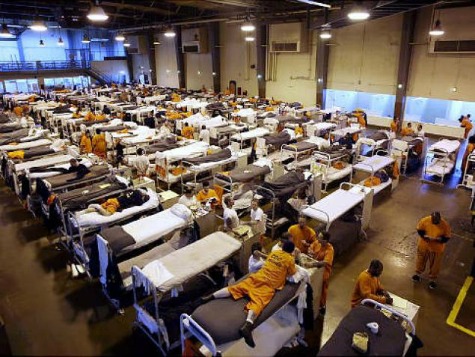
Crime rates across America are down and the prison population is up. Is there a connection? You bet there is.
Since 1980, the overall crime rate has dropped by nearly 40 percent. According to FBI statistics, there were 1.9 violent crimes committed in 1992 versus 1.2 million in 2011, even though the US population increased by almost 70 million. Nonviolent crime is down by comparable numbers. During the same period, the number of people in American prisons has increased by leaps and bounds.
Criminologists agree that a relatively small number of criminals commit the bulk of crimes. These chronic habitual offenders often commit hundreds of crimes in their lifetime; in fact, some studies have concluded that as few as six percent of a given age group commits more than 80 percent of the violent and serious property crimes of that age group. Lock these guys up, the theory goes, and crime will drop precipitously. That theory was adopted during the 1980s and early 1990s, laws were changed, the police and prosecutors cracked down, and major emphasis was placed on locking up these career criminals for long periods of time.
Although the changes have been effective, it is no secret that there are other reasons why the crime rate has dropped, including better and smarter policing, an aging population (most crime is committed by people younger than 35), and more effective crime prevention programs.
So incarceration of people prone to committing crime after crime is effective, at least if we identify and convict the right criminals. Trouble is, we do not always lock up only the right people, and in many cases the system has gotten so aggressive and so many new criminal laws have been enacted that we are locking up people, often for nonviolent offenses, and spending too much money for questionable results that would be better served elsewhere.
While nobody (except the inmates) wants to see prisons turned into the Ritz-Carlton, in some cases conditions and inmate behavior are so horrible that non-violent offenders leave prisoners more dangerous to society than when they went in. States are seeing recidivism rates between 40 percent and 60 percent, showing that prisons may be keeping criminals locked up but are doing a poor job of preparing them for reintegration into society once they are finally released.
Almost half the people locked up are serving time for drug-related crimes. Costs have exploded from $9 billion in 1985 to $50 billion today. In some states, prisons are the second-fasted growing part of the budget, outpaced only by the behemoth Medicaid.
Too many resources are committed to nonviolent offenders that could be devoted to violent criminals. To make matters worse, after being locked up with murderers, rapists, and robbers, many of these nonviolent offenders become violent themselves. Instead of rehabilitation, too many of our prisons are really violent crime factories–something we should not want to spend our tax dollars mass producing.
One problem is mandatory minimum sentencing, which denies judges any discretion over the sentence a defendant will receive. In some cases, a young person can simply be found riding in a car that has drugs in it and then the government makes a substantial part of their life disappear–with nothing anybody can do about it.
Like many things, mandatory minimum sentences and policies like California’s “three strikes and you’re out” started with good intentions. Liberal judges were handing out sentences that were too lenient, leading to a revolving door for violent criminals. This predictably helped spark a surge in violent crime beginning in the mid-1960s.
In the 1980s and 90s, conservatives decided to handcuff these liberal judges by passing laws that took violent crime seriously. People were being sent to prison and made to do real time. The result was a major drop in crime, especially as repeat offenders–dubbed the “superpredators”–were unable to ply their trade.
But it is possible for the pendulum to swing too far in the other direction, and now it has. The United States now locks up a quarter of the world’s prisoners. One adult out of every 33 is subject to the correctional system in some capacity. Worst of all, the federal government is making crimes of too many things.
In a piece titled “You’re Probably A Criminal,” Brian Walsh of the Heritage Foundation supplied examples of ordinary, nonviolent people imprisoned due to overcriminalization. “Every year, thousands of upstanding, responsible Americans run afoul of some incomprehensible federal law or regulation and end up serving time in federal prison,” he wrote.
“There is an urgent need to address the astronomical growth in the prison population, with its huge costs in dollars and lost human potential,” former House Speaker Newt Gingrich wrote in 2011. “The criminal-justice system is broken, and conservatives must lead the way in fixing it.”
The key is to handle this through legislation and proper policy, not by executive fiat as Attorney General Eric Holder has tried to do. Rand Paul is working with Democrats in the Senate to reform mandatory minimum sentences. Congressman Louis Gohmert is working in the House to stop the expansion of federal criminal law to regulate practically everything. Jeb Bush, Grover Norquist, David Keene, and Richard Viguerie are among the major conservative figures who have made prison reform a priority.
Law enforcement has also played a key role in this. Nobody is more familiar with the human cost of violent crime than the people who put their lives on the line every day to fight it. But police officers are very familiar with wasted resources and bureaucratic rules that make no sense. They do not want to spend their time arresting people for frivolous charges and they do not want a counterproductive criminal justice system.

COMMENTS
Please let us know if you're having issues with commenting.